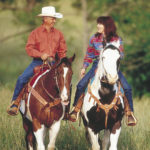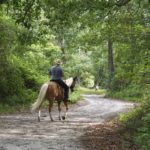Have you grown bored with driving on your farm? Are you looking for a more economical way to run errands? Would you enjoy a relaxing and satisfying drive on a warm, sunny morning, actually going somewhere? Think how nice it would be to listen to the rhythm of your horse’s hooves and appreciate the beauty of nature . . . IF you can do it without worrying about your horse becoming the next Rocket Man.
My purpose in this series is to help you prepare to drive in the most ?non horse friendly? environment you can imagine: the public roads. When I was asked during my professional carriage-driving career what it is like to drive in city traffic, I described it as similar to navigating a sailboat in a crowded harbor of power boats.
Motorists do not realize (or care) that unlike a machine, the horse has a mind of his own. In their eyes you are driving him, therefore you must be in control. (We know that is true, but only to a certain extent.) Automobile drivers will not notice the plastic bag blowing across the field and heading straight for the road in front of your carriage. Kids on a school bus will not be the only occupants of passing vehicles to yell, and possibly throw things at you. There are people of all ages in this world who think it is funny to see your horse bolt, as a result of something they did. (Worse yet is the prankster who spies a horse tied outside a store and turns him loose only to laugh as he runs away.) By end of my career as a professional carriage driver, not much about the behavior of people toward horses surprised me.
Horses have the right of way on many states? roads, but most motorists do not know it. I would rather be the one to yield, than stand my ground (like a sailboat asserting its right of way over an oil tanker!) and risk getting hurt. Don?t expect any considerations and when you do experience them, make sure to signal your appreciation.
?Real World? Road Perils
- Air brakes on trucks and buses: These always seem to hiss when right alongside the carriage. Consider yourself lucky if these vehicles even slow down.
- ?Engine brakes or ?jake brakes?: An 18-wheeler whose driver is applying these sounds like a huge, growling animal.
- Roadside equipment: Beyond the bend is a landscaping crew with mowers, trimmers and blowers all going full tilt. They are too busy to look up and notice a carriage coming down the street, nor can they hear anything.
- ?More: Vehicles pulling noisy trailers, dump trucks with debris dropping off the back, sirens blasting on emergency vehicles, dogs barking and/or chasing the carriage, huge motor coaches, riders on bicycles and loud motorcycles are just a few examples. The better you prepare yourself and your horse to deal with the public-road environment, the more you will be able to enjoy the very real pleasures of driving in it.
Make Yourself Visible
Increase visibility by attaching a flag in a conspicuous color like blaze orange or neon green to the carriage on a tall pole, Wear a safety vest with reflective tape, hang an SMV sign on the rear of the carriage and put a banner on the back of the carriage asking motorists to pass wide and slow. Attach reflective and/or neon green tape on the banner to make it even more noticeable. Bicycle shops carry battery-powered clip-on blinking red lights that will attach to the carriage. Put reflective tape on your helmet, and reflective bands on your horse’s legs and bridle.
It’s good to be audible as well as visible: Put sleigh bells on the harness to make your presence known to humans and wildlife.
Check Out the Route
By driving your planned route in a car, you can locate potential advantages and hazards. Riding a bicycle along the route may be even more useful as the slower speed will enable you to see more?and your perspective from a bicycle will be similar to what you see from a carriage. On the positive side, look for places where you can turn the carriage around, or get off the road safely. Wide shoulders, driveways and parking lots are ideal, but stay off private property unless you have permission from the owner. As possible drawbacks, look for such things as ditches, blind curves, potholes, unguarded drop-offs, culverts and anything else which could cause a major problem.
Before starting out on your carriage drive, always tell someone which direction you are going and what time you expect to return?or leave a note to that effect. A stated ?drive plan? makes it easier for friends or family to look for you if necessary.
Choose Your Time
The time of day you drive can make a big difference in what you will encounter on the road. Go out between morning and evening rush hours, and in the late morning on Sunday. Motorists are more likely to be considerate and willing to share the road with a slower-moving vehicle when they are not late for work, in a hurry to get to the soccer game or trying to beat the crowd at the yard sales. Some drivers will slow down out of curiosity, while others will be anxious to pass because you have the audacity to be in their way.
If there are hunting seasons in your area, find out the schedule and avoid all roads while the season is in progress.
Signal Your Intentions
Prepare to be the best and most defensive, courteous driver on the planet by learning standard hand signals, the same that were routine for automobile drivers before the advent of flashing directional signals. Executed as follows, your hand signals will be clear, leaving no doubt of your intentions. Prior to signaling, put the whip in your right hand along with the reins. ALL SIGNALS WILL BE MADE WITH YOUR LEFT ARM unless you have a passenger, as noted below.
- Turn to the right: Extend your left arm out straight at shoulder height and bend your forearm upward, creating a right angle.
- Turn to the left: Extend your left arm straight out at the shoulder with no bend at the elbow.
- Stop: Extend your left arm out straight from the shoulder and bend your forearm downwards.
- Intersections: As you would put your horse in danger by driving far enough into an intersection to see clearly from the box, ask your groom to get down and guide the carriage safely through. If traffic is following behind, allow those drivers to make their own choices.
NEVER wave a motorist to pass! This action could result in a lawsuit, should an accident occur.
If you have a passenger sitting next to you, ask the passenger to execute the signals. Motorists are unlikely to recognize who is driving the carriage and will expect a hand signal from the left side of a vehicle as they would from a car. (When given on the right, signals can also be hidden by foliage or misunderstood.) At the beginning of every ride, assign only one person the responsibility for signaling and ask any junior passengers to keep still.
Drive the carriage in the center of the lane as you would a motor vehicle. (All roads have a crown for drainage, in the middle where the centerline for the road is painted. Normal grade for this crown is 2 percent, or about 1/4 inch for every foot of road width, not enough to make a noticeable difference for a carriage.) Look ahead as far as possible for potential problems, giving yourself maximum time to decide on any needed course of action. A friend or family member following no less than 100 feet behind you in their vehicle, with emergency flashers on, is a great way to create a buffer zone. It is well worth the extra precaution! And never engage in a confrontation with a motorist; your horse will get excited and it is a no-win situation for you. Instead, carry a pen and pad to jot down the license plate number and make a report to the police as soon as possible. Better yet, keep a camera handy.
Prepare for Problems en Route
- Dogs: What to do about dogs who bark and chase the carriage? Consider carrying a can of pepper spray, but use caution with this type of deterrent. Turn away from the direction of the spray, especially on a windy day (and avoid spraying into the wind). Resist the urge to hit a dog with the whip, or use anything which makes noise? your horse could react in an undesirable way, and it’s off to the races! Check with local law enforcement agencies to find out the best way to repel dogs chasing the carriage; they may have an idea that would work better for you. The last thing you want is a citation for hitting someone?s dog with a whip.
- The manure problem: If you drive in residential areas, some neighbors might feel a pile of horse manure on the road in front of their house is reason enough to call the police to complain, so consider training your horse to wear a diaper. The best design in my experience is a nylon bag with a zipper on the bottom for clean, easy manure disposal. The diaper fits snugly under the tail, straps adjust to fit almost any pony or horse and it is virtually unnoticeable with the harness. These bags are washable, keep the manure out of sight, don’t leak and will last a long time.
When the Open Road Won’t Do
Laws in most states do not prohibit horses from the public roadways, but would you want to drive where traffic is moving at a high rate of speed? Shoulder or not, it is far too dangerous and not worth the risk. If your horse swerves to avoid a roadside hazard, that puts you directly in the path of vehicles traveling in excess of 50 miles per hour. It can happen so quickly that a motorist would not be able to avoid a collision.
If driving on local streets is not feasible, consider hauling your horse and carriage to another location. Possibilities include private estates, public parks, ?multi-use? hiking or nature trails and unpaved roads in the country or on government-owned land. State parks often have miles of well-maintained and clearlymarked roadways ideal for driving, Check first to find out about things like fees, limitations on where driving is allowed, or a curfew when the park closes. Free maps are usually available at the visitor?s center. Some roads are only open to the public upon request. Horses are increasingly being banned from using some state lands because of numerous complaints from hikers, campers and bicyclists, so be very considerate and don’t give other users anything to complain about.





